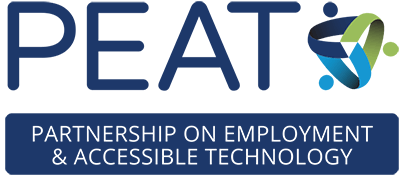Accessible Technology in the Workplace
By Josh Christianson
 February is Low Vision Awareness Month — a time to raise awareness about vision rehabilitation services among people with low vision. It's also a good time to consider the technology needs of employees and job seekers with visual impairments. After all, technology is essential to applying for and doing many jobs. And, as long as the technology is accessible, it can help you succeed in employment long-term.
February is Low Vision Awareness Month — a time to raise awareness about vision rehabilitation services among people with low vision. It's also a good time to consider the technology needs of employees and job seekers with visual impairments. After all, technology is essential to applying for and doing many jobs. And, as long as the technology is accessible, it can help you succeed in employment long-term.
Getting What You Need
Individuals with disabilities — including those with low vision — who understand how accessible and assistive technology (AT) can help them in their career choices are most likely to be successful. Being proactive is the key. Here are 7 steps you can take:
- Consider the technology you're using now. Begin by taking a look at the technology you use in your daily life — for example, mobile devices, email software, and social networking apps. By reviewing everything you already use successfully, you'll be prepared to identify tools you can use to be most productive at work.
- Know Your Rights. Under federal law, qualified job applicants and employees with disabilities are generally entitled to "reasonable accommodations," which often include accessible and/or assistive technologies. For more information, see the Job Accommodation Network's (JAN) guidance for individuals and advice on how to request an accommodation.
- Recognize your role. Access to AT is about more than legal requirements for employers; it's also about being able to advocate for yourself and increase your productivity in the workplace. So educate yourself on the tech tools you need to be successful and actively work to obtain them. Commit to ongoing training on the technology solutions you use to make sure you maximize their accessibility features.
- Identify what you need. Whether you plan to ask for an accommodation or take advantage of a "bring your own device" policy, part of the conversation with your employer means explaining what you'll need to use at work. Read Taking Stock of Your Workplace Technology to learn more.
- Build a technology support network. Keep in touch with peers and product developers who have technology expertise, and with professionals or advocacy groups who are familiar with accessibility. In addition, develop relationships with the technology staff in your workplace to help you stay up-to-date on changes, new technology and best practices for using the technology.
- Address compatibility. The AT you use at home may be different from what you use at work. That means there may be features that work differently, and some of the technologies may not be compatible with the same software, meaning they won't automatically work the way you expect. Take some time to learn the technology and collaborate with the company that makes the technology and your employer.
- Become part of the long-term solution. Finally, position yourself as an advocate and team player in your workplace. Your employer may have a process for buying and implementing new technologies, and there may be opportunities for you to help guide that process for AT. See Becoming an Accessible Technology Advocate to learn how to talk with your employer about the benefits of an accessible workplace — one where all employees can perform at their highest level.
About the blogger
Josh Christianson is the project director of the Partnership on Employment & Accessible Technology (PEAT). Funded by the U.S. Department of Labor's Office of Disability Employment Policy, PEAT is a multi-faceted initiative that fosters collaboration and action around accessible technology in the workplace. To learn more visit www.PEATworks.org.
About Ticket to Work
Social Security's Ticket to Work (Ticket) program supports career development for people ages 18 through 64 who receive Social Security disability benefits (SSI or SSDI) and want to work. The Ticket program is free and voluntary. It helps people with disabilities move toward financial independence and connects them with the services and support they need to succeed in the workforce.
Learn more
You can call the Ticket to Work Help Line at 866-968-7842 or 866-833-2967 (TTY) Monday through Friday, 8 a.m. to 8 p.m. ET. Ask a representative to send you a list of service providers or find providers on your own with the Ticket program Find Help tool.